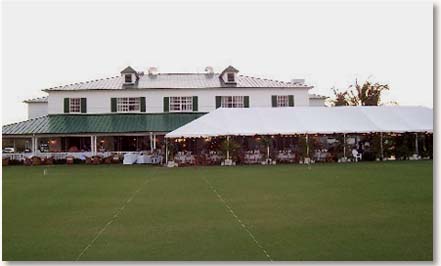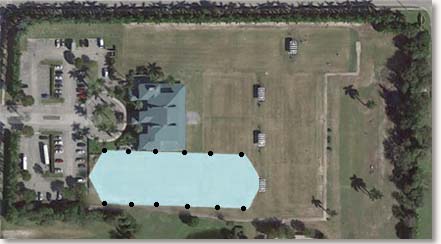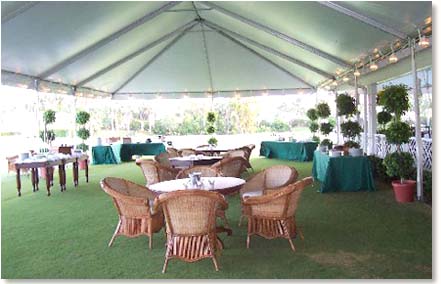

|
Back to |
| The Front Page |
| News & Features |

|
Florida's Croquet Dome two steps ahead of other sports enclosures |
||||||
|
By Bob Alman Photos by Scott Reiser Site plan courtesy of Derek Wassink Posted August 14, 2016
|
||||||
|
||||||
Derek Wassink--who happens to be the highest-ranked croquet player at the Center as well as owner and chief engineer of a firm in nearby Delray--told me he had two purposes in mind in proposing the project in January 2016 to the Croquet Foundation of America as his first "dome" client: First, to demonstrate for potential future clients the strength of the new polymer-based space-age lightweight fabric that is key to the engineering and overall economy of the design; secondly, to document on film the construction process, which is just as meticulously engineered as the breakthrough fabric itself, as part of securing other/similar contracts in other locales.
The Croquet Foundation has accepted, after long deliberation, the proposal of a local award-winning engineering firm for the construction of the world's first Croquet Dome at the National Croquet Center. Construction is planned to begin "sometime after Easter" of 2017 and to be completed by the virtual beginning of the local season in October of 2017. Be sure to read the entire story in the Croquet World Online scoop!
Thirdly, he adds, "I love this Center, I learned to play here, I often compete here, and I want to help keep this place absolutely, no question, the world-wide mecca of the sport."

|
| Tenting is often rented for clients who want covered downstairs dining for more than the 150 or so who can be accommodated in the Grill and on the veranda. |
The design--finalized in concert with Wassink's architectural partner Steinberg & Watkins--incorporates the existing 12 lighting standards installed in 2015 and first used in a major tournament for the final game of the WCF World Championship in April, 2016. Laterally reinforced with rigid steel beams connecting the standards and further reinforced by the strength of the housing for the fabric around them, those twelve reinforced standards will become the major structural elements of the design, with strengthened footings sufficient to withstand the pressures of hurricane-force winds.
Toughest engineering challenge: wind tolerance
"Engineering the wind tolerance is actually the most challenging part of this design," Wassink explains. "The Dome in its standard configuration will withstand wind gusts up to 70 mph." When winds exceeding that strength appear possible (not just likely but possible) the structure can be adjusted to withstand them; In the rare instance of a hurricane (which last came to Palm Beach County with Wilma in 2006) the huge panels constituting the roof can be "unzipped" and housed in the architecturally altered and reinforced members around the original lighting standards.
On either end of the Dome, the tenting will slope down to within 10 feet of the ground. In the west side it will be tethered to a single column aligned with a short lighting standard for the parking lot. On the east side, the existing gazebo will be reinforced to serve the same purpose. The Space-X fabric on either end can be quickly loosed and rolled up by the Center staff as a low-level response to wind velocity.
The vertical and horizon contours at both ends of the long structure, combined with the fabric connecting to the clubhouse, helps to mediate the appearance of bulk on the three sides of the structure most visible to players and event clients. (See the Site Plan below.)

|
| On this site plan, the blue expanse indicates the approximate dimensions of the Dome and its relationship to the clubhouse. The angles at either end and the downward slant of the canopy connecting with the clubhouse and the gazebo reduce the impression of bulk and create a visual relationship between the Dome and the courts and clubhouse. The Space-X fabric of the canopy is opaque but translucent, letting light through and cutting out almost half the UV radiation. |
Another tactic for engineering the wind applies to the four-foot "apron" around the top of the Dome. Stabilized with small weights, this apron can respond freely to the wind and absorb its force, without needing adjustment. The apron is thus a semi-permanent element of the Dome--even in the rare instance of a response to a hurricane requiring taking the large fabric sections of the dome down and storing them around the lighting standards.
How the lighting standards become structural elements
At first glance, the lighting standards seem unpromising as structural elements. But Wassink explains, "Our architectural partner first suggested that we try to use them as structural elements to minimize the interference with the visual field of spectators at sports events. Part of the solution of the engineering puzzle was that with the addition of one-inch steel lateral beams connecting and stabilizing the entire structure, we saw that the engineering was actually doable."
For forecast storms of hurricane dimensions a work crew of four will have to be employed for about a half day, requiring just one cherry picker to secure the twelve huge panels of the fabric dome in specially prepared housings around the lighting standards. "Yes," Wassink admits, "it will be an expense--but a hurricane hasn't hit this region for a long time, and there will be plenty of time to prepare, so we can ensure surviving with zero damage." In addition, part of the agreement is that Wassink's firm will absorb the cost of the first two such instances. And all of it will be included in the filming of the building, installation, and take-down.

|
| Sometimes the food stations for big events are set up on the broad grass apron between the clubhouse and courts, enclosed by all-weather tenting. |
"Any such occurrence will actually be useful as a demonstration of this fabric's strength and our structural engineering expertise, further showing the advantages of this extraordinary strong flexible fabric over any kind of rigid dome, which would of course be much more expensive."
Nobody, including the Croquet Foundation of America, will quote an exact figure. General Manager Marie Sweetzer estimates, however, that the Dome will "pay for itself" by the year 2021. Wassink agrees with that estimate.
Fabric a by-product of Space-X development
Not just Wassick and his engineering firm, but the owners, the Croquet Foundation of America, have taken every step to clear the way for construction, and that includes being mindful of the close neighbors, who have been assured they will not have to suffer the glare of the court lights beyond 12 midnight more than once a year, and then only in a true scheduling emergency.
The Palm Beach County Zoning Commission has signed off on the project as well, mindful that the promise of Palm Beach County''s Sports Commission--"Palm Beach County--the best of everything"--is already fulfilled by the existence of the world's biggest and best croquet facility. Now they can add to that, "with the world's first all-weather sports dome for croquet."
Event Manager Scott Reiser and long-time resident caterer SandyJames are also pleased with the development, and looking forward to getting yet another competitive advantage over other popular event sites. Up to now, Reiser has needed to include in many clients' price estimates rental costs for temporary all-weather coverings. Now, there will be plenty of rain cover, connecting the South Veranda to the Dome, and clients can create more weather protection for "outdoor" dining by merging the Dome covering with more tenting for the East Veranda.
Wassink's firm has been one of several long-term testers of the fabric that makes this project and others like it feasible. California's Space-X has agreed to license a limited supply of the fabric for commercial application, following the successful completion of stage one of the testing (based on terrestrial trails.)
But it isn't really a dome, is it?
| Growing into the Vision |
|
More than one expert on organizational dynamics has observed that enterprises seldom achieve stasis--that is, reaching a certain size, dimension or configuration and staying there in that stabilized position over time; instead, they either expand or contract. They require an organizing force to elaborate "the next step" of expansion or change to move towards actualizing it. Merely "improving" or "restoring" cannot be relied upon as a sustaining force. For example, a plan for "restoring the Back Nine as a pristine playing surface for croquet and other sports" is laudable, as is improving the plantings on the 10-acre site, reported recently. But "improving" or "expanding" doesn't mobilize financial support or create positive free media and publicity and attract clients. On the other hand, elaborated new projects like the Croquet Dome or one that would propose buying the adjacent church property between the parking lot and the undeveloped lawn east of the irrigation pond to add parking capacity and create an additional regulation lawn actually do tend to generate that kind of support. They expand the vision and inspire broad-based support and enthusiasm within the founding vision.
|
Up to now, most "all-weather sports domes" have been rigid, some of them with ingenious light-weight design (allowing opening almost the entire dome if/when the weather permits). Wassick is confident that the super-strong Space-X fiber will enable the cost-effective construction of many other "sports domes" engineered on the same principles he and his company are pioneering at the National Croquet Center.
Wassink's confidence is such that he has guaranteed that the Croquet Foundation of America will not have to pay for any cost over-runs beyond the contracted estimate. He has further committed to having his staff on hand--free of charge--to oversee the first and second storm-proofing that will require the twelve panels to be housed around the lighting standards.
But where does the rain go?
Wind engineering is one thing, but what about engineering for the rain--its weight and drainage? Wassink smiles slyly. "Now THAT is something we're not giving away until the design is nearly constructed. We think our solution is unique, and we're applying for a patent on it."
In failing to give any specific cost or price figures, both Wassink and Sweetzer will only say, "It's surprisingly low." That's not only because of the relative strength and economy of using a flexible-fabric based design. It's also because it's a small area to cover, compared with a dome that shelters hockey, or soccer, or baseball, or football, or any of the major sports.

|
| This photograph of a huge event shows much of the covered areas embraced by the new Croquet Dome. Potential event clients will see that their party would be protected from weather by an already existing canopy, without needing to rent additional cover. |
Rick Landry, the Center's new pro, experienced in both croquet and tennis, tells me that the three lighted courts will accommodate two grass tennis courts, with easily installed temporary fixtures. Covered grass tennis on the circuit with spectators and sponsors could potentially extend the Center's income and publicity outreach in tandem with the Dome.
Wassink's design needs to cover no more than an area of roughly 325" long and 115" wide. But the Space-X fabric will extend to the building on the north side, which means bleachers there will be covered in the 20-foot-wide space between the building and the lawns for major events. (Uncovered temporary bleachers may, of course, be installed on the south side.)
The design even includes a square concrete foundation in the corner of the east "apron"--about 30 feet wide--that separates the clubhouse veranda from the courts. It can support an elevated platform for cameras and commentators, near the center of the complex with power extensions from the second floor of the clubhouse.
We hope to have a real cost figures when we run the story about the completed installation of the Croquet Dome in the fall of 2017. The Center's management as well as Derek agreed, when I approached them having heard a rumor about the Croquet Dome, that publicity almost a year in advance of construction of this visionary project would not be inappropriate now, after all. We expect this news to be picked up and reported in the mainsteam press and to become a "running story" in the local press for the next year and a half--and a national story when the Dome is first used for a major event--probably in October of 2017.
"First evers" always get the press they deserve. Croquet World Online is proud and privileged to have the first substantial story about the world's first Croquet Dome. Chuck Steuber, visionary founder and financer of the Center, would be very pleased, indeed.
Bob Alman is the long-time editor of CROQUET WORLD ONLINE MAGAZINE who moved to West Palm Beach in 2000 to organize and manage the National Croquet Center for Chuck Steuber, who as president of the Croquet Foundation of America financed the world's biggest and best facility as the USCA headquarters. Alman is still much involved at the Center, at the age of 77, consulting frequently with Sweetzer and Reiser as well as the resident members club, and volunteering as an every-Saturday "floater" for the Center's year-round free introduction to the sport. Everything in this story is absolutely true--except, of course, for the elaborated description of the Croquet Dome, which is whole-cloth fantasy. He wholeheartedly thanks Derek Wassink, Marie Sweetser, and Scott Reiser for going along with the wholly invented but mostly logical story of the Dome. Why didn't he do this at the beginning of April? "That would have been too obvious." More significantly, "If we were not a small fringe sport, the National Croquet Center could actually do something like this, in a spectacular way, to further its mission as the global 'showcase' for the sport."